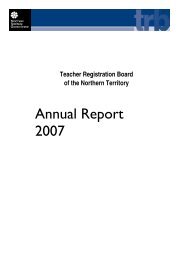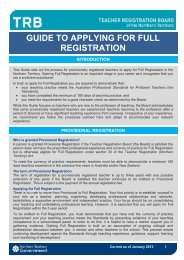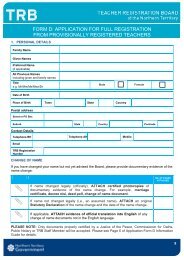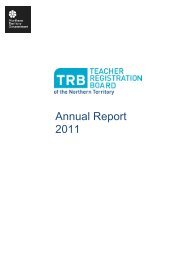First year out Five top tips from Phil Beadle Teacher preparation ...
First year out Five top tips from Phil Beadle Teacher preparation ...
First year out Five top tips from Phil Beadle Teacher preparation ...
You also want an ePaper? Increase the reach of your titles
YUMPU automatically turns print PDFs into web optimized ePapers that Google loves.
editorial state of the nation<br />
The Commonwealth<br />
government’s Review of<br />
Funding for Schooling chaired<br />
by David Gonski released<br />
its Review of Funding for<br />
Schooling: Emerging issues<br />
paper in December last <strong>year</strong>.<br />
That was followed by the<br />
panel’s third communiqué in<br />
March, which indicated that<br />
the panel had commissioned<br />
a comprehensive program<br />
of research to inform its<br />
deliberations. Members of the<br />
panel have also been busy<br />
since February, undertaking<br />
a series of school visits to<br />
hear more ab<strong>out</strong> the issues<br />
raised by key education<br />
groups during the initial<br />
consultations last <strong>year</strong>. The<br />
panel will complete those<br />
school visits by May, no doubt<br />
taking copies of submissions<br />
in response to the Emerging<br />
issues paper with them.<br />
There’s every sign of diligence<br />
in the panel’s activities, but<br />
one needs only to look at the<br />
media frenzy over funding<br />
unleashed when the revamped<br />
My School website was<br />
launched to see that funding<br />
is likely to be an ideological<br />
touchpaper.<br />
Many students across Australia<br />
were affected by natural<br />
disasters in recent months,<br />
while others have experienced<br />
vicarious trauma as a result<br />
of saturation media coverage,<br />
particularly following the<br />
massive 8.9 magnitude Tōhoku<br />
earthquake and tsunami off<br />
the north-east of Japan on<br />
Friday 11 March. An estimated<br />
550,000 people have been<br />
displaced, possibly 100,000<br />
of them children, according to<br />
Save the Children. SchoolAid is<br />
working with Save the Children<br />
to support Japanese children<br />
directly affected by the disaster.<br />
Head of KidsHelpLine Wendy<br />
Protheroe said such support<br />
also helps children in Australia<br />
to cope with disaster-related<br />
trauma. Students and teachers<br />
at the Sydney Japanese School<br />
observed a minute’s silence on<br />
the Monday after the disaster.<br />
The earthquake and tsunami<br />
occurred as schools in New<br />
Zealand were reopening after<br />
a 6.3-magnitude earthquake<br />
devastated the Christchurch<br />
region on 22 February. Ninety<br />
schools reopened in February,<br />
while 24 remained closed,<br />
pending further assessment<br />
for structural damage. Eleven<br />
seriously damaged schools were<br />
relocated on sites shared with<br />
undamaged schools. The NZ<br />
Ministry of Education established<br />
nine ‘learning hubs’ to provide<br />
resources and further support for<br />
schools and students.<br />
Some 7,500 students have moved<br />
with their families and have<br />
enrolled in schools <strong>out</strong>side the<br />
Christchurch region. NZ Education<br />
Minister Anne Tolley said she<br />
expected many families to return.<br />
‘Once the schools are open and...<br />
the city starts getting itself back<br />
on its feet, I’m sure some families<br />
will come back,’ she said.<br />
In Queensland, northern New<br />
S<strong>out</strong>h Wales and Victoria,<br />
teachers and students are also<br />
recovering <strong>from</strong> a summer<br />
of disasters following flood<br />
inundation and, in Queensland,<br />
damage caused by Cyclone Yasi.<br />
The Queensland Department<br />
of Education and Training and<br />
school staff readied 89 of 92<br />
flood-affected schools for the new<br />
school <strong>year</strong>. Northern NSW was<br />
also flooded although schools<br />
were generally unaffected. Nine<br />
schools in Victoria’s north-east<br />
were closed at the beginning of<br />
the school <strong>year</strong> after floods there<br />
in February.<br />
In Western Australia, three<br />
schools s<strong>out</strong>h-east of Perth were<br />
closed under threat of bushfire<br />
and two schools in the state’s<br />
north-west were closed due<br />
to extreme weather, while 74<br />
schools in the Northern Territory<br />
were closed due to a cyclone<br />
warning.<br />
LINKS<br />
www.schoolaid.org.au<br />
april Inside Teaching is shining<br />
the spotlight on your school!<br />
Simply answer the question below for your chance to<br />
win one of seven aCER vouchers each valued at $200.<br />
There is one winner in every state and the NT!<br />
Special prize: One lucky winner will have a photographer visit their school to have their photo<br />
taken with students, with the story published in the June edition. An ACER representative will<br />
be in touch to discuss details.<br />
Question: There’s a link between Inside Teaching’s feature on Canterbury Boys High<br />
School (clue: answer on page 6) and our 20 questions interview with Jane Caro (clue:<br />
answer on page 32). What is it?<br />
To enter, simply click here to answer the question.<br />
We thank you for making Inside Teaching your professional journal, and remember, if you aren’t a winner<br />
this time, try your luck again in the next edition of Inside Teaching.<br />
Terms and conditions:<br />
1. The entrant must answer a question on page 5 of Inside Teaching (electronic<br />
publication). The answer is found within the body of the article featured on page 6.<br />
2. The competition opens on 11 April 2011, 9am EST.<br />
3. The competition closes on 13 May 2011, 5pm EST and the draw will occur on 18 May<br />
2011 at approximately 5pm EST.<br />
4. The entrant fills in a form (click through to the entry).<br />
5. One entry per person and only correct answers to the competition question will be<br />
considered.<br />
6. 1 (one) winner for each of the 7 $200 vouchers will be drawn <strong>from</strong> each state and<br />
the Northern Territory and <strong>from</strong> those winners a further winner for the special prize<br />
will be drawn.<br />
7. Each winner will be notified by email and the winners’ names will be published in the<br />
next edition of Inside Teaching (June edition 2011).<br />
8. A voucher entitles each winner to choose $200 worth of ACER books and resources<br />
<strong>from</strong> ACER bookshops or may be used towards the purchase price of a more expensive<br />
product. ACER will contact the winner and organise the prize choosing and dispatch.<br />
9. Each winner will receive his or her voucher within one month after the draw.<br />
10. Postage: $200 worth of product redeemed by voucher will be sent to the school (or<br />
nominated address) free of charge. Should the school choose to purchase additional<br />
products, normal postage fees will apply.<br />
11. The winners will be drawn at 19 Prospect Hill Road, Camberwell Victoria 3124.<br />
12. The winners will be notified via email.<br />
13. The winners will be published at http://www.acer.edu.au/forms/inside-teachingcompetition<br />
.<br />
14. If required, a redraw will take place on the 1 June 2011 at 19 Prospect Hill Road,<br />
Camberwell Victoria 3124.<br />
15. Entrants’ personal information may be used for future communications activities<br />
including the compilation of a mailing list by ACER only. Entrants’ details will not be<br />
passed on or sold to a third party.<br />
16. ACER (Australian Council for Educational Research) ABN 190043981555.







